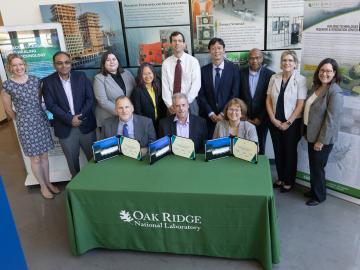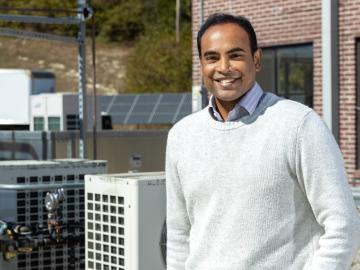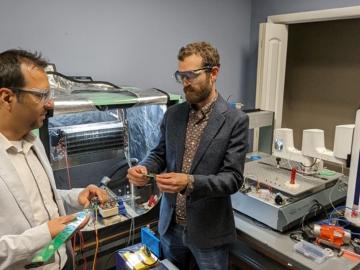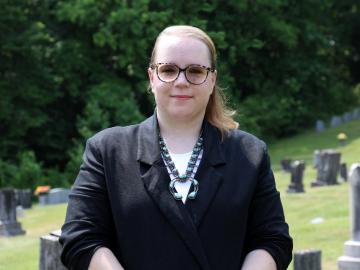
Filter News
Area of Research
News Type
News Topics
- (-) Buildings (25)
- (-) Molten Salt (3)
- 3-D Printing/Advanced Manufacturing (61)
- Advanced Reactors (14)
- Artificial Intelligence (44)
- Big Data (20)
- Bioenergy (48)
- Biology (53)
- Biomedical (30)
- Biotechnology (17)
- Chemical Sciences (44)
- Clean Water (9)
- Composites (15)
- Computer Science (77)
- Coronavirus (23)
- Critical Materials (13)
- Cybersecurity (23)
- Education (3)
- Element Discovery (1)
- Energy Storage (56)
- Environment (78)
- Exascale Computing (16)
- Fossil Energy (1)
- Frontier (19)
- Fusion (26)
- Grid (23)
- High-Performance Computing (43)
- Hydropower (2)
- Isotopes (33)
- ITER (3)
- Machine Learning (23)
- Materials (69)
- Materials Science (71)
- Mathematics (5)
- Mercury (6)
- Microelectronics (1)
- Microscopy (28)
- Nanotechnology (35)
- National Security (35)
- Neutron Science (64)
- Nuclear Energy (44)
- Partnerships (33)
- Physics (42)
- Polymers (18)
- Quantum Computing (14)
- Quantum Science (36)
- Security (19)
- Simulation (18)
- Space Exploration (3)
- Statistics (1)
- Summit (24)
- Transportation (38)
Media Contacts

A team led by scientists at ORNL identified and demonstrated a method to process a plant-based material called nanocellulose that reduced energy needs by a whopping 21%, using simulations on the lab’s supercomputers and follow-on analysis.

As a mechanical engineer in building envelope materials research at ORNL, Bryan Maldonado sees opportunities to apply his scientific expertise virtually everywhere he goes, from coast to coast. As an expert in understanding how complex systems operate, he’s using machine learning methods to control the process and ultimately optimize performance.

Flexcon Global has exclusively licensed two patented inventions to manufacture a self-healing barrier film from ORNL for research and development purposes. The film can be incorporated into vacuum insulation panels to increase the efficiency of buildings during retrofits. Under a cooperative research and development agreement that began in 2021, Flexcon and ORNL have been exploring the capabilities of the technology and fine-tuning its properties.

Researchers for the first time documented the specific chemistry dynamics and structure of high-temperature liquid uranium trichloride salt, a potential nuclear fuel source for next-generation reactors.

Seven entrepreneurs comprise the next cohort of Innovation Crossroads, a DOE Lab-Embedded Entrepreneurship Program node based at ORNL. The program provides energy-related startup founders from across the nation with access to ORNL’s unique scientific resources and capabilities, as well as connect them with experts, mentors and networks to accelerate their efforts to take their world-changing ideas to the marketplace.

Cheekatamarla is a researcher in the Multifunctional Equipment Integration group with previous experience in product deployment. He is researching alternative energy sources such as hydrogen for cookstoves and his research supports the decarbonization of building technologies.

Although he built his career around buildings, Fengqi “Frank” Li likes to break down walls. Li was trained as an architect, but he doesn’t box himself in. Currently he is working as a computational developer at ORNL. But Li considers himself a designer. To him, that’s less a box than a plane – a landscape scattered with ideas, like destinations on a map that can be connected in different ways.

Four ORNL teams and one researcher were recognized for excellence in technology transfer and technology transfer innovation.

Walters is working with a team of geographers, linguists, economists, data scientists and software engineers to apply cultural knowledge and patterns to open-source data in an effort to document and report patterns of human movement through previously unstudied spaces.

In a finding that helps elucidate how molten salts in advanced nuclear reactors might behave, scientists have shown how electrons interacting with the ions of the molten salt can form three states with different properties. Understanding these states can help predict the impact of radiation on the performance of salt-fueled reactors.


